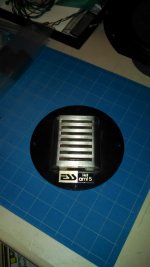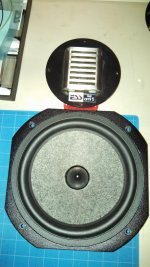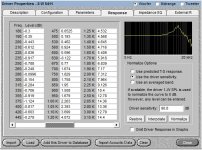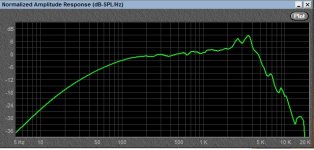I've been shootin' from the hip on this project for far too long.
Time to throw it out there for the wolves to feed on. 😉
This first thread will define my project:
LF Driver: 8" Focal 8W 5411, Z=6, Pe=90W, SPL=90.8Db.
HF Driver: ESS Heil AMT5, Z=4, SPL aprox. 94Db.
The Parameters and Specifications are vastly unknown for the AMT5.
Any information would be greatly appreciated.
8W 5411 WinISD Box Design:
23L Vented Enclosure Tuned at 50Hz.
Programs:
WinISD for box design.
X-Over Pro v3.0 for crossover design.
XSim for signal simulations.
Textbooks:
Great Sound Stereo Speaker Manual 2nd. edition.
The Loadspeaker Design Cookbook 6th. edition.
X-Over Pro Users Manual.
Personal: I'm a system analyst for the local power company. Although I know very little about Electronics. Formally a Draftsman with CAD experience. Very analytical and technical in nature. Huge lover of music.
I look forward to completing this first project with your help and recommendations. Details coming later.
Time to throw it out there for the wolves to feed on. 😉
This first thread will define my project:
LF Driver: 8" Focal 8W 5411, Z=6, Pe=90W, SPL=90.8Db.
HF Driver: ESS Heil AMT5, Z=4, SPL aprox. 94Db.
The Parameters and Specifications are vastly unknown for the AMT5.
Any information would be greatly appreciated.
8W 5411 WinISD Box Design:
23L Vented Enclosure Tuned at 50Hz.
Programs:
WinISD for box design.
X-Over Pro v3.0 for crossover design.
XSim for signal simulations.
Textbooks:
Great Sound Stereo Speaker Manual 2nd. edition.
The Loadspeaker Design Cookbook 6th. edition.
X-Over Pro Users Manual.
Personal: I'm a system analyst for the local power company. Although I know very little about Electronics. Formally a Draftsman with CAD experience. Very analytical and technical in nature. Huge lover of music.
I look forward to completing this first project with your help and recommendations. Details coming later.
Attachments
Not sure what you need xover pro for if you have xsim.
What you are missing are measurement tools. save the money from xover pro and spend it on omnimic+dats
What you are missing are measurement tools. save the money from xover pro and spend it on omnimic+dats
Funny you should mention that. 🙂
Might make that investment.
What I like about X-Over Pro is the driver database.
Although lacking the ESS drivers.
I really like XSim for it's free style design.
But honestly struggling with how to deal with the driver data.
How can you model crossovers without driver parameters?
Still learning. Discovered Circuit Blocks tonight.
Might make that investment.
What I like about X-Over Pro is the driver database.
Although lacking the ESS drivers.
I really like XSim for it's free style design.
But honestly struggling with how to deal with the driver data.
How can you model crossovers without driver parameters?
Still learning. Discovered Circuit Blocks tonight.
The driver database in XOver Pro is useless. I bought it for the same reason. It doesn't have anything more than the published T/S parameters. I still feel cheated. Never mind the difficulties I had getting the thing to work. The driver database in WinISD is as good, if not as complete, but it's free. 🙂
For your work, with drivers in your hands, DATS is better.
For your work, with drivers in your hands, DATS is better.
This what you referring too:
Dayton Audio OmniMic V2 and DATS V2 Speaker Measurement Bundle
That's the one. 🙂
That plus XSim and you will be amazed how fast everything goes.
Best,
Erik
It doesn't have anything more than the published T/S parameters. I still feel cheated.
I appreciate what you are saying here.
I've considered buying this package so that I could then create the data files I need for the Heil AMT.
The lack of data for these ESS drivers is what's holding me back on the crossover designs. I was hoping someone on this forum could provide them. Still hoping for now.
However, X-Over Pro most certainly does provide FRD data for most commercially available drivers. I have been able to model the Focal 8W FR, Phase, Impedance and Group Delays most efficiently.
It is not the most flexible application. 🙂
As a systems analyst, I have worked with many programs throughout the years. One thing is certain. No One program has everything you need and does it well.
This my friend, includes X-Sim. Where one falls short the other fills in, and visa-versa.
What I'm hearing, is spend $300 on this package instead of $100 for X-over Pro (which I already own).
Create all my own data files, instead of using existing driver databases.
And send $10 to the Church of the Sacred Bleeding Heart of Jesus,
Located somewhere in Los Angeles, California.
And next week they'd say my prayer on the radio, and all my dreams would come true. 🙂
(Sorry, got a little carried away with The Stones.)
But seriously, I hear what you’re saying.
This could be a very valuable tool. A must.
And I hope you will be open to helping me with X-Sim when I get to the Crossover thread. Your experience with this application is golden.
I'm more than likely going to end up purchasing the package.
What's another $300 at this point. 🙂
Also, I have taken your advice posted to montana1 regarding the process.
Hence the new threads.
Regards, Baron.
If XOver Pro has actual FR data that's news to me. I' tried finding it and asking here. Could you tell me how to find that either in the manual or the program itself?
OmniMic will do all your measurements, eliminating the need for either XOver Pro's database or other blending techniques I see people spend a lot of time on. It's also not as full featured as other programs. It relies on a CD for the test measurements so you have to derive driver distances yourself, which is straightforward. However you wont' run into any of the issues of blending near field + farfield that others here have grown accustomed to. I've been shaking my head wondering why so many DIY'ers spent so much time getting accurate measurements when I realized, thanks to OmniMic all that work with spreadsheets and nearfield vs. farfield issues went away.
Having said that, most here use REW. If I really had money I'd buy Pocket CLIO. 🙂
My process, and it's in large part thanks to OmniMic, for 2-way system, after having a cabinet made:
- Measure tweeter and woofer at 3'.
- Measure tweeter + woofer at 3'.
- Measure driver impedances in cabinet (more for the woofer than tweeter).
- Import OmniMic + DATS data into XSim,
- Derive driver distances.
- Model crossover.
- Buy parts.
- Build Crossover
- Done.
Most DIY'ers spend a lot of work to do near and farfield, use Jeff Bagby's spreadsheet, blah blah blah. 😀 😀 I skip all of that. For many it's so routine they don't think it's much work at all though.
Mind you, this process only works because our crossover point is so high. With a 3-way and a below 500Hz crossover point the Bagby approach makes more sense, as you'll need more consistent phase and amplitude data. It's not really more accurate, but it is much more consistent and less dependent on the environment. This makes nearfield measurements far more reliable for filter design in the bass region.
For a 2-way however, put on some rose colored glasses when looking at the bass response and you'll be more accurate. You'll see the actual in room response, just have to ignore the peaks and valleys that go with the room response.
Best,
Erik
OmniMic will do all your measurements, eliminating the need for either XOver Pro's database or other blending techniques I see people spend a lot of time on. It's also not as full featured as other programs. It relies on a CD for the test measurements so you have to derive driver distances yourself, which is straightforward. However you wont' run into any of the issues of blending near field + farfield that others here have grown accustomed to. I've been shaking my head wondering why so many DIY'ers spent so much time getting accurate measurements when I realized, thanks to OmniMic all that work with spreadsheets and nearfield vs. farfield issues went away.
Having said that, most here use REW. If I really had money I'd buy Pocket CLIO. 🙂
My process, and it's in large part thanks to OmniMic, for 2-way system, after having a cabinet made:
- Measure tweeter and woofer at 3'.
- Measure tweeter + woofer at 3'.
- Measure driver impedances in cabinet (more for the woofer than tweeter).
- Import OmniMic + DATS data into XSim,
- Derive driver distances.
- Model crossover.
- Buy parts.
- Build Crossover
- Done.
Most DIY'ers spend a lot of work to do near and farfield, use Jeff Bagby's spreadsheet, blah blah blah. 😀 😀 I skip all of that. For many it's so routine they don't think it's much work at all though.
Mind you, this process only works because our crossover point is so high. With a 3-way and a below 500Hz crossover point the Bagby approach makes more sense, as you'll need more consistent phase and amplitude data. It's not really more accurate, but it is much more consistent and less dependent on the environment. This makes nearfield measurements far more reliable for filter design in the bass region.
For a 2-way however, put on some rose colored glasses when looking at the bass response and you'll be more accurate. You'll see the actual in room response, just have to ignore the peaks and valleys that go with the room response.
Best,
Erik
Last edited:
It's very possible we are talking about two different things regarding XOP.
I've attached some attachments. 😀
The database provides "Acoustic Response" from the Response tab.
Not sure if that equates to FRD.
With just the driver loaded, second pic shows Default 8W 5411 response.
Looks exactly like the PDF.
I realize this is factory default, and not actual.
I know what you are really saying is do the real measurements before the crossover design.
I've been struggling with this realization. Thanks for the free therapy. 🙂
So going with your suggestion to build the cabinet and take measurements.
Thereby needing exactly the tools you've recommended.
I've attached some attachments. 😀
The database provides "Acoustic Response" from the Response tab.
Not sure if that equates to FRD.
With just the driver loaded, second pic shows Default 8W 5411 response.
Looks exactly like the PDF.
I realize this is factory default, and not actual.
I know what you are really saying is do the real measurements before the crossover design.
I've been struggling with this realization. Thanks for the free therapy. 🙂
So going with your suggestion to build the cabinet and take measurements.
Thereby needing exactly the tools you've recommended.
Attachments
Hi BoB!
That's interesting, that's a lot more data from XOP than I had. 🙂 I didn't mean to say it was just factory traces. I meant I couldn't find anything near that.
The only thing I could find in XOP was T/s parameters. As far as I could see besides the T/S parameters it seemed to act as if everything was ideal. Clearly I missed a lot in there!
Focal is a lot better with the T/S parameters than other vendors though. Odd, cause they make crap tweeters.... but I digress. Point is, you can start designing a box for a Focal woofer or midrange from the spec sheet and be pretty close.
If you were going with ScanSpeak, I'd say trust nothing, not even the nominal diameter. 😀 : D That's a little exaggeration, but with cause.
Best,
Erik
That's interesting, that's a lot more data from XOP than I had. 🙂 I didn't mean to say it was just factory traces. I meant I couldn't find anything near that.
The only thing I could find in XOP was T/s parameters. As far as I could see besides the T/S parameters it seemed to act as if everything was ideal. Clearly I missed a lot in there!
Focal is a lot better with the T/S parameters than other vendors though. Odd, cause they make crap tweeters.... but I digress. Point is, you can start designing a box for a Focal woofer or midrange from the spec sheet and be pretty close.
If you were going with ScanSpeak, I'd say trust nothing, not even the nominal diameter. 😀 : D That's a little exaggeration, but with cause.
Best,
Erik
- Status
- Not open for further replies.
- Home
- Loudspeakers
- Multi-Way
- ESS-Focal 2 Way (Project Definition)



